| welcome | introduction | paradise | profile | fact file | land | people | places | history | buddhism | LINKS |
| wildlife | beaches | scenery | images | anuradhapura | sigiriya | kandy | tea | terrorism | update | HOME |
(N.B. As this is a very large document with graphics and images, it may take sometime to download. However, if you click under 'land' on the menu above, you can view this document in parts thus distributing the download time into sections.)
| National Parks and Sanctuaries |
| Conservation of Wildlife |
| The Elephant Orphanage |
(Some of the extracts below are by courtesy of the websites maintained by the Ceylon Tourist Board and The Sri Lanka Wild Life Conservation Society.)
Though Sri Lanka is very small in land area, the great diversity in habitats harbors are a rich and diverse fauna and flora, with many species endemic to the island. Historically as well as in the modern era, successive rulers and governments of Sri Lanka have strived to provide sanctuary and protection to our beautiful wildlife. Today the demands and aspirations of an expanding human population makes it difficult for the government to be solely responsible for the protection, preservation and management of this beguiled wild heritage of ours. Today, especially where human interest and wildlife interest are in direct conflict. It is imperative that private organizations with resources step into and fill the areas that need immediate attention: environmental education, long term research, and to develop integrated projects for community based conservation.
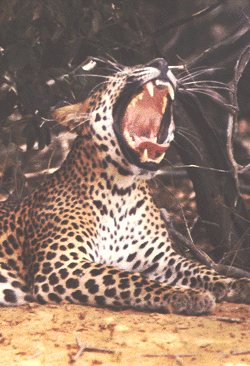 |
Of the four species of wild cats found in Sri Lanka, the leopard is the largest. No information exists for all the species of cats in regard to their population, distribution and status. There is also small scale poaching of all the species of cats for their skins, teeth and meat. |
| The sloth bear is the only species of bear found in Sri Lanka, further research is needed to find out more about its ecology, distribution and status. | 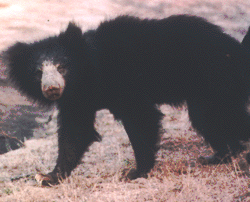 |
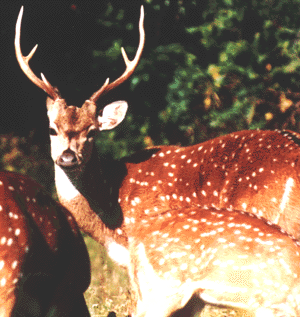 |
Of the five species of deer found in Sri Lanka, the spotted deer and its cousin, the sambar, have the largest distribution. Though there are still large populations of spotted deer in some areas, all five species of deer are relentlessly poached for venison. Studies to ascertain their ecology, distribution and status are urgently needed. |
| Sri Lanka has more than 400 species of birds consisting of residents, visitors and migrants. Of this 26 species are endemic to the island. Large and small scale clearing of jungles and forests, causes local extinctions of the more specialized species, and threatens the survival of others. It is imperative to establish regional and urban wildlife sanctuaries for their long term survival. | 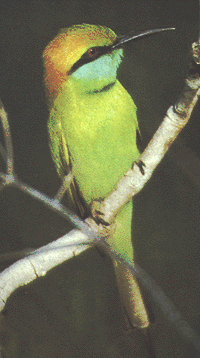 |
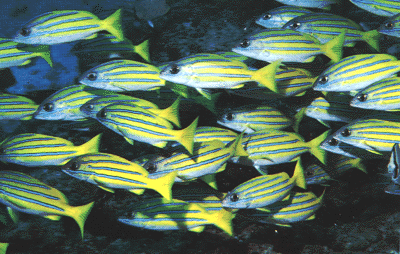 |
The inland waters of Sri Lanka have more than 60 species of fresh water fish of which over 24 species are only found in Sri Lanka. Closer to a 1,000 species of fish are found in the coastal waters surrounding the island. Domestic and industrial affluents and pollutants discharged into rivers and other waterways are a threat to the survival of these fresh water and coastal fishes, and other marine ecosystems such as coral reefs. |
| The territorial waters of the Indian Ocean is also home to a rich and varied marine life. Five species of sea turtles and 25 species of whales and dolphins inhabit these coastal waters. | |
|
|
|
Fifty three species of amphibians are found in Sri Lanka, of which over 25 species are endemic. |
| The cobra is one of the most well known snakes of the over 90 species of snakes found in Sri Lanka. There are also many species of lizards, two species of crocodiles and monitors, two species of aquatic turtles and one species of tortoise found in the island. | 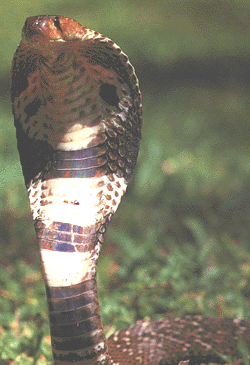 |
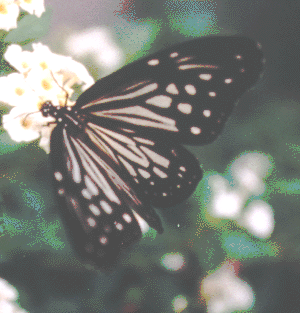 |
Of the diverse and amazing array of invertebrates found in Sri Lanka, there are over 240 species of butterflies, of which 14 species are endemic. |
| Sri Lanka also has a wealth of plant life of which a majority are endemic to the island. Many species of colorful and rare orchids, ferns, ayurvedic herbs and plants, large trees, bromeliads and epiphytes creates colorful, exotic and rich habitats for other animal life, and a salubrious environment for humans. |
|
| welcome | introduction | paradise | profile | fact file | land | people | places | history | buddhism | LINKS |
| wildlife | beaches | scenery | images | anuradhapura | sigiriya | kandy | tea | terrorism | update | HOME |
The jungles of Sri Lanka abound in a variety of wildlife,which is surprising for an island of its size in the tropics.From ancient days the elephants and peacock from the Sri Lankan jungles were prize exports to the Kingdoms of East and West.But apart from these well known examples of the fauna, a visit to the Sri Lankan jungles is to enter a whole new world where nature has largely stayed still.There are four majour national parks.Of these the best known is Ruhunu National Park,at Yala,in the deep South of the island.The other well known national park,at Wilpattu,is at present closed due to the prevailing conditions in the North of the island.There are also two other national parks at Inginiyagala and Udawalawe.
Sri Lanka has a rich and exotic variety of wildlife and a long tradition of conservation rooted in its 2,230 year old Buddhist civilisation. The following are the most important sanctuaries in terms of attractions, accessibility and availability of facilities.Animal
Sanctuaries
| The animals to be seen in Sri Lanka's national parks include elephant, leopard, sloth bear, sambhur, deer and monkeys, wild buffalo, wild boar (pig), porcupine, ant-eater, civet cat, jackal, mongoose, loris (unique to sri Lanka) several varieties of lizards, squirrels, reptiles and amphibians. Each park however has its own specialities. |
![]()
Yala (Ruhuna)
National Park
While the elephant is undoubtedly the best known attraction at Yala,Seen in small and large herds,what is the most appealing here is the overall mood of the undisturbed jungle.Large herds of spoted Deer are seen all over the Park,as are many Sambhur,and for those who are sharp eyed to observe,many of the endemoc Muntjac or Barking Deer.Monkeys-the pinkish Rhesus and the grey faced Langur Monkey,live and play on the tree-tops and the ground below. Wild Buffalo and Wild Boar could give you a good surprise and a great picture,while sight of a leopard sunning itself or drinking at a water hole could be a memorable experience,As dusk gathers,there is every chance of seeing the Ceylon Sloth Bear scampering with its young on it back.the progress of your vehicle could be held up by a Python across the track,and near the many waterholes will bee found whole colonies of Crocodiles.
The Peacock is easily the most famous of the birds at Yala.The mating dance
of the male,with its colourful plumes fully spread,is a photographer's
delight.While the Peacock has its fame,there are also many other species which
attract those who are interested in bird life,and add to the mood and feel of
nature.The Painted stork,many varities of heron,the poonbill,the bee-eater,many
colourful parrots and parakeets,the hornbill,kingfisher and wood-pecker and
hoopoe are all birds that can be seen by the observant in the jungles of Sri
Lanka. There is accomodation in the national parks of Sri Lanka in
special bungalows maintained by the Department of Wild Life
Conservation.Dry rations are taken by the visitors and they are made
for you by caretakers who are expert at turning quick,tasty meals.Travel inside
the parks only by a vhicle.Four- wheel drive is recomended.Entry to the parks
is by special
permit.
| Situated 309 km. south of Colombo, Yala is approximately 1,259 sq.km. in extent and is located in the south eastern corner of the island. Its northern boundaries border on the Lahugala Elephant Sanctuary and it has the added bonus of a scenic ocean frontage. The terrain is varied flat plains alternating with rocky outcrops. The vegetation ranges from open parkland to dense jungle. Water holes, small lakes, lagoons and streams provide water for the animals and birds. The speciality here is the large numbers of elephants. |
![]()
Wilpattu National
Park
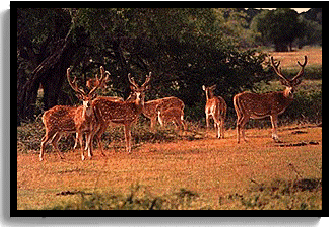
| Situated 176 km. north of Colombo, Wilpattu is approximately 1,908 sq.km. in extent. It has a dense jungle cover which makes it a more exciting park where animals have to be tracked. There are numerous delightful little lakes - known as villus - and the leopard and sloth bear are the speciality rather than elephants. |
![]()
Gal Oya National
Park
| Situated at Inginiyagala, the Gal Oya National Park is 314 km. from Colombo and is most renowned for its elephant population. |
Uda Walawe National Park
Situated 170 km. South East of Colombo the Uda Walawe National Park is
approximately 30,821 hectares in extent. This Park which lies within the
Ratnapura and Monaragala Districts acts as the catchment to the Uda Walawe
Reservoir and is located in the Dry Zone. This Park comprises grasslands and
thorn scrubs and many valuable species of trees are found within it. Large
herds of Elephants and Deer species such as spotted Deer, Sambhur, Barking deer
and Langur, Wild Boar, Water Buffalo, Jackal are some of the prominent wild
animals found in this Park and a variety of avifauna is seen.
![]()
Maduru Oya
National Park
The Maduru Oya National Park is located in the Dry Zone and is 300 km. away
from Colombo and 58,849 hectares in extent. A wide variety of wildlife
including some endemic birds species and reptiles are found here. Maduru Oya is
rich in ancient ruins found in different places and its southern parts provide
veddhas, indigenous people their living environment. Endemic purple monkey is
among the important animal species that can be seen in addition to Sambhur, a
member of the cat family etc. There are some endemic avifauna also found within
this Park.
![]()
Wasgamuwa National Park
| Situated approximately 200 km. away from Colombo, the Wasgamuwa National Park lies within the Polonnaruwa and Matale Districts and have the Mahaweli river and Amban river as its eastern and western boundaries. Tropical intermediate dry mixed evergreen forest predominates its environment. |
![]()
Horton Plains
National Park
| The Horton Plains National Park is the only National Park situated in the Hill Country and falls within the Nuwara Eliya district and is 200 km. away from Colombo. Panoramic scenic beauty of the Hill Country could be witnessed within the Park. The famous `Worlds End' is a major attraction within the Park. Endemic slender loris and endemic purple monkey are among the important animal species that could be seen in addition to sambhur, a member of the cat family etc. There are some endemic avifauna also found within this Park. |
![]()
Bundala National Park
Bundala National Park is the latest addition to the National Parks and is
situated 260 km. away from Colombo. All species of waterbirds resident in the
country and the migrant birds inhabit this Park.
![]()
Bird Sanctuaries
| The sanctuaries at Kumana 312 km. from Colombo, Wirawila 261 km. Bundala 259 km. and Kalametiya 224 km. are all lagoon locations in Sri Lanka's extreme south eastern coast. The Giant's Tank in the north western corner of the island is a huge ancient irrigation reservoir of 3,800 hectares. The coastal sanctuaries are exotically picturesque with combinations of lagoon, swamp, river, jungle, lake and plain. Large flocks can be found here of both resident and migrant aquatic birds. The highland sanctuaries at Udawattakele 118 km. from Colombo and the Peak Wilderness 141 km. are quieter but equally picturesque with wooded hills and secluded streams and have the added bonus of rare flora such as our unique Wesak Orchid as well as numerous species of rare butterflies. The Udawattakele Sanctuary is in the suburbs of Kandy, our picturesque and fascinating hill capital. The Peak Wilderness is situated on the slopes of Adam's Peak (Sri Pada), Sri Lanka's sacred mountain. |
![]()
National
Zoological Gardens
| Situated 11 km. from the Fort, the Zoo has a fine collection of animals, birds, reptiles and fish from all over the world. The aquarium is the only one of its kind in Asia and displays over 500 varieties of aquatic life. Also walk in through Aviary, Reptilium, Butterfly Park. There are daily elephant performance at 5.15 p.m. Open daily between 8.00 a.m. and 6.00 p.m. Entrance fees : Rs 90/- per adult and Rs.45/- per child. |
![]()
Elephant Orphanage
| An orphanage for elephants has been set up by the department of National Zoological Gardens, at Pinnawela, 90 km. from Colombo. It was established in 1975 and several animals brought here at the inception are now mature enough for breeding, which is the ultimate aim of the institution. Entrance fees : Rs.75 per adult and Rs.40 per child. |
![]()
Wild
Life and Nature Protection Society
| For all information on nature safaris, hiking and birdwatching and advice on itineraries please contact Headquarters at Chaitiya Road, Marine Drive, Fort, Colombo. Tel. 325248 Telex : 21537 METALIX CE & 22933 Metalix CE Attn WPNS. Fax: 941-580721 Attn. WPNS |
| welcome | introduction | paradise | profile | fact file | land | people | places | history | buddhism | LINKS |
| wildlife | beaches | scenery | images | anuradhapura | sigiriya | kandy | tea | terrorism | update | HOME |
You are not permited to alight from your vehicle within the park,except at specially marked locations.Camping is permitted at special camping sites,with prior permission.You must always be accompanied by a tracker provided by the park authorities.Please refrain from disturbing the peace of the wild with the use of radios,casette and CD players or loud music of your own.And,as in any other place,but more so in the wild,do not leave any litter behind.Park Bungalows Visitors to National Parks could find accomodation in Park Bungalows maintained by the Wil Life Conservation.All bungalows have basic amenities;water on tap, refrigerators, toilet, cutlery, crockery and presure lamps.Services of Bungalow Keeper and Assistant provided.
| Reservations:Minimum of five persons (children under 12 years at half rate at US$ 10/- per person per day.Bookings only through Department of Wild Life Conservation,493,T.B. Jaya Mawatha,Colomo 10,Tel- 094-691321 , 688261/2. Hints to those who rent park bungalows-Take your dry rations and linon.Take plenty of fresh fruit-pineapple,papayas,banana,mango etc.Vegetables,some drinking water,coke,soda and other carbonated drinks,liquor,suger,eggs,bread,bacon,frozen or roast meat.Please note that once you are in the park you will have to travel several miles outside the park to reach the nearest town,and there too all your needs may not be found.Take a stock of fuel for your vehicle. |
| But just make sure nothing is found wanting at the other end.If you are touring on your own make sure to obtain all provisions from Colombo,or at least Galle or Matara (if travelling on the Southern route);Haputale or Bandarawela (if coming through the hills) and Ratnapura (if comming from the gem country).Those visiting Wilpattu should obtain supplies from Kurunegala,Puttalam or Anurdapura.Take plenty of Photographic films with you. All tourist who visit the National Park are required to pay a park fee and a vehicle fee.This applies to those who rent park bungalows as well.Park fees: Rs. 100/- per prson per day.Vehicle fees: Rs. 10/- per jeep (four-wheel drive vehicle. Entry to Ruhunu National Park-Yala,is restricted to 30 vehicles at any given time. Use of a four-wheel drive vehicles is recommended. |
| Your bungalow cook is used to the preperation of both Western and Eastern five star hotel. Casual VisitorsCould avail themselves of conducted tour leaving Yala Park Office and Wilpattu Park Office at 6 a.m & 3 p.m.for a 2-1/2 hour tour of either.The Park entry fee is Rs.50/- per paxJeep hire for a pax of 5 is Rs.625/- (not including park fees).Seat in a mini coach at yala is Rs.140/- and Wilpattu Rs.150/- (inclusive of park fee). |
| welcome | introduction | paradise | profile | fact file | land | people | places | history | buddhism | LINKS |
| wildlife | beaches | scenery | images | anuradhapura | sigiriya | kandy | tea | terrorism | update | HOME |
The theme of wildlife conservation has been an ancient concept in Sri Lanka. It was considered noble in keeping with the teachings of Gouthama Buddha and later essential to the Island.
| "...... ordering by beat of drum that no
animals should be killed within a radius of seven gau from the city
(Anuradhapura) the King gave security to animals. He gave security also to the
fish in the twelve great tanks and bestowing on Kambodin-gold and cloth and
whatever other kind of wealth they wished, he commanded them not to catch birds
and so gave security to birds." Royal decree of King Kirthi Nissanka Malla of Polonnaruwa (2nd Century AD) Stone inscription at Ruwanveli Dagaba, Anuradhapura. |
Sri Lanka, because of her diverse physical environmental and tropical situation, harbours rich biological diversity of global significance far larger in proportion to her size. While her cultural traditions have always enshrined the concern for all life, the Island has nearly fourteen per cent of her land area earmarked for the conservation of biodiversity and wildlife. Of the fourteen per cent, twelve per cent are Protected Areas under the Department of Wildlife Conservation. This stands out in comparison with most other countries in South Asia Region.
| Sri Lanka's Wildlife Conservation |
|
|
See
list below for statistics on the numbered locations.

Protected Areas of Sri Lanka
Protected areas shown on the
map
| National Parks |
|||
| Map # | Name of Protected Area | Land Area in Hectares | Established |
| 1 |
Wilpattu National Park | 131,693.9 | 02.25.1938 |
| 2 |
Somawathiya Chaitiya National Park | 37,762.2 | 09.02.1986 |
| 3 |
Floodplains National Park | 17,350.4 | 08.07.1984 |
| 4 |
Wasgomuwa National Park | 36,948.0 | 08.07.1984 |
| 5 |
Maduru Oya National Park | 58,849.8 | 11.09.1983 |
| 6 |
Gal Oya National Park | 25,900.0 | 02.12.1954 |
| 7 |
Lahugala Kitulana National Park | 1,554.0 | 10.31.1980 |
| 8 |
Horton Plains National Parks | 3,159.8 | 03.16.1988 |
| 9 |
Kumana (Yala East) National Park | 18,148.2 | 01.02.1970 |
| 10 |
Yala (Ruhuna) National Park | 103,882.9 | 02.25.1938 |
| 11 |
Uda Walawe National Park | 30,821.0 | 06.30.1972 |
| Sanctuaries and Reserves |
|||
| 12 |
Chundikullam Sanctuary | 11,149.5 | 02.25.1938 |
| 13 |
Kokilai Sanctuary | The whole lagoon | 05.18.1951 |
| 14 |
Madhu Sanctuary | 26,677.0 | 06.28.1968 |
| 15 |
Padaviya Sanctuary | 6,475.0 | 06.21.1963 |
| 16 |
Yoda Weva Sanctuary | 4,330.3 | 09.24.1954 |
| 17 |
Sober Islands Sanctuary | 71.0 | 06.21.1963 |
| 18 |
Naval Headworks Sanctuary | 18,130.0 | 06.21.1963 |
| 19 |
Anuradhapura Sanctuary | 3,500.7 | 05.27.1938 |
| 20 |
Mihintale Sanctuary | 999.6 | 05.27.1938 |
| 21 |
Seruwavila Sanctuary | 15,540.0 | 10.09.1970 |
| 22 |
Ritigala Strict Nature Reserve | 1,528.1 | 11.07.1941 |
| 23 |
Minneriya-Giritale Sanctuary | 7,529.1 | 02.12.1988 |
| 24 |
Sigiriya Sanctuary | 5,099.2 | 01.26.1990 |
| 25 |
Polonnaruwa Sanctuary | 1,521.7 | 05.27.1938 |
| 26 |
Kegalle Kurulu-Kelle Sanctuary | 113.3 | 03.14.1941 |
| 27 |
Kandy Uda-Watte Kelle Sanctuary | 104.0 | 07.29.1938 |
| 28 |
Victoria-Randenigala-Rantambe Sanctuary | 42,088.8 | 01.30.1987 |
| 29 |
Peak Wilderness (Samanala) Sanctuary | 22,379.9 | 10.25.1940 |
| 30 |
Sinharaja Rainforest Sanctuary* | ||
| 31 |
Wirawila-Tissa Sanctuary | 4,164.4 | 05.27.1938 |
| 32 |
Bundala Sanctuary | 6,216.0 | 12.05.1969 |
| 33 |
Bellanvila-Attidiya Sanctuary | 372.0 | 07.25.1990 |
| 34 |
Yala Strict Nature Reserve | 28,905.7 | 03.01.1938 |
| Other Protected Areas not shown on the map |
|||
| 35 |
Hakkgala Strict Nature Reserve | 1,141.6 | 02.25.1938 |
| 36 |
Tricona-Madu | 25,019.4 | 10.24.1986 |
| 37 |
Wilpattu North | 632.0 | 11.07.1947 |
| 38 |
Thel-Watte | 1,424.5 | 02.25.1938 |
| 39 |
Katagamuwa | 1,003.7 | 05.27.1938 |
| 40 |
Gallways Land | 56.7 | 05.27.1938 |
| 41 |
Thanga-Malley | 131.5 | 05.27.1938 |
| 42 |
Rocky Islands (Ambalangoda) | 1.2 | 10.25.1940 |
| 43 |
Kataragama | 837.7 | 05.27.1938 |
| 44 |
Palle-Malala | 13.8 | 10.23.1942 |
| 45 |
Wel-Hella Katagilla | 134.4 | 02.18.1949 |
| 46 |
Senanayake Samudra | 2,324.0 | 02.12.1954 |
| 47 |
Gal-Oya East | 12,432.0 | 02.12.1954 |
| 48 |
Gal-Oya South East | 15,281.0 | 02.12.1954 |
| 49 |
Vauwni-Kulam | 4,856.3 | 06.21.1963 |
| 50 |
Sagamam | 616.5 | 06.21.1963 |
| 51 |
Padawiya Tank | 6,475.0 | 06.21.1963 |
| 52 |
Kimbulwana Oya | 492.1 | 06.21.1963 |
| 53 |
Maha Kandarawa Tank | 400 yards around the tank | 12.09.1966 |
| 54 |
Seruwila-Allai | 15,540.0 | 10.09.1970 |
| 55 |
Ma Indul Kande-Nittambuwa | 23.5 | 10.31.1972 |
| 56 |
Paraithivu Island | 97.1 | 05.18.1973 |
| 57 |
Kudumbi-Gala | 4,403.0 | 09.28.1973 |
| 58 |
Horagolla. | 13.4 | 10.05.1973 |
| 59 |
Honduwa Island | 8.5 | 11.19.1973 |
| 60 |
Bundangala | 1,841.4 | 11.01.1974 |
| 61 |
Pigeon Island | 4.6 | 11.01.1974 |
| 62 |
Ravana-Ella | 1,932.0 | 05.18.1979 |
| 63 |
Hikkaduwa Coral Reef | 44.5 | 05.18.1979 |
| 64 |
Sri Jayawardene Pura | 449.2 | 01.09.1985 |
| 65 |
Kahala-Palle Kelle | 21,690.0 | 07.11.1989 |
| 66 |
Parapuduwa Meheni Island | 189.6 | 08.17.1988 |
| 67 |
Kalametiya Lagoon | 712.3 | 06.28.1984 |
| welcome | introduction | paradise | profile | fact file | land | people | places | history | buddhism | LINKS |
| wildlife | beaches | scenery | images | anuradhapura | sigiriya | kandy | tea | terrorism | update | HOME |
 They say an elephant
never forgets, but what happens when an elephant is forgotten? In Sri Lanka,
abandoned elephants who cannot survive in the wild find refuge at the Elephant
Farm at Pinnewela (near Rambukkana).
They say an elephant
never forgets, but what happens when an elephant is forgotten? In Sri Lanka,
abandoned elephants who cannot survive in the wild find refuge at the Elephant
Farm at Pinnewela (near Rambukkana).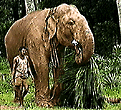
People feed, groom and care for 46 elephants on the farm. The babies drink milk warmed to body temperature from super-size bottles, seven per feeding.
"Maybe at first they can't find their own food. So we bring it to them here," said Idris Salley, a caretaker at the elephant farm.
Outcasts like Raja, an old blind elephant who was wounded by hunters, live on the farm, as does an elephant rumored to have killed more than a dozen people.
The farm supports itself in part through tourists, who come for a rare close-up view of the animals.
The orphans arrive from across the country, rescued from remote villages where they have lost their mothers to quarry accidents, shootings or lynch mobs.
At the Elephant Orphanage, deep in the tropical hill country of central Sri Lanka, the motherless calves are raised by human foster parents who ply them with bottled milk five times a day and give them an occasional swig of beer in an effort to help preserve Asia's dwindling wild-elephant population.
"Without the orphanage, most of them would be left to die or be killed," said Wijepala Ranbanda, curator of the elephant orphanage.
In Sri Lanka and throughout Asia, some of the world's larger remaining wild-elephant herds - about 50,000 animals across the continent - face threats to their survival from burgeoning human populations that are bulldozing forests into farmland and severing centuries-old migration routes with highways and urban development.
In recent months the competition for space between man and beast has led to unprecedented clashes as the giant pachyderms, squeezed out of their native habitat, have attacked villagers, raided farm crops and, recently, stormed the outskirts of Calcutta.
India is home to an estimated 40 per cent of the world's Asianelephant population, which is overwhelmingly wild, with only a few thousand domesticated and used for work or religious purposes.
"The scenario is rather bleak," said J. C. Daniel, a member of the steering committee of India's Project Elephant, a new government effort to protect wild elephants. "The main problem facing us today is habitat destruction. There is frequent straying into human settlements, where they raid the crops and people shoot them."
A single rogue elephant was blamed for the deaths of 27 villagers during a 10-day rampage in the northeastern Indian state of Assam last fall. Other marauding elephants also attacked farmers, razed crops and guzzled barrels of rice beer stored in village huts. The government dispatched mounted troopers to hunt down the beasts.
In January, panic-stricken residents of Calcutta erected giant walls along the city's borders to stop a herd of elephants that had strayed from customary migration paths.
"There has been a human explosion in the area," said Ashish Ghosh, director of the Calcutta-based Zoological Survey of India, which has been studying elephant-migration patterns. "There have been more and more disturbances in their normal migration routes. This is the first time in recent memory that these herds have come so close to urban habitat."
In Sri Lanka, a small island nation that is home to an estimated 3,000 wild elephants, the problem of diminishing habitat is even more acute. The island has been stripped of 50 per cent of its forest land in the last three decades, dramatically affecting the elephant herds.
"They want to roam, and they overlap with the people," said curator Ranbanda of the Elephant Orphanage, which was created in 1975 by government officials worried about habitat encroachment.
In the last 19 years, the number of deserted, maimed and impaired elephants that are provided foster care has jumped from about 10 a year to 56 last year. Some of the orphans raised in the sanctuary of palm groves and rolling grassland are now rearing their own babies at the orphanage.
The sheer size of the elephants makes them far more susceptible to the problems of human encroachment than tigers, rhinoceroses and other endangered animals that tend to live in small pockets, wildlife officials said.
The orphanage's newest arrival weighed 60 kilograms (132 pounds) when she was born nearly two months ago. She will drink about 25 litres of milk a day until she's weaned after 4 1/2 years.
| welcome | introduction | paradise | profile | fact file | land | people | places | history | buddhism | LINKS |
| wildlife | beaches | scenery | images | anuradhapura | sigiriya | kandy | tea | terrorism | update | HOME |
NEW COUNTER INSTALLED SINCE 4 AUGUST 2001
|
You are Visitor No:
|
Sign
My Guestbook ![]() View
My Guestbook
View
My Guestbook